Daikin RZQG71LV1B, RZQG100LV1B, RZQG125LV1B, RZQG140LV1B Installation manuals
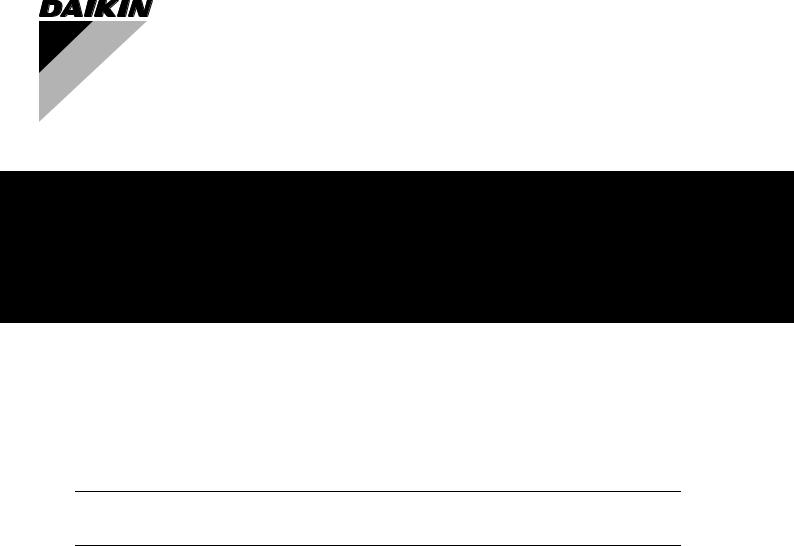
INSTALLATION MANUAL
Split System air conditioners
MODELS
RZQG71LV1B
RZQG100LV1B
RZQG125LV1B
RZQG140LV1B
READ THESE INSTRUCTIONS CAREFULLY BEFORE INSTALLATION.
KEEP THIS MANUAL IN A HANDY PLACE FOR FUTURE REFERENCE.
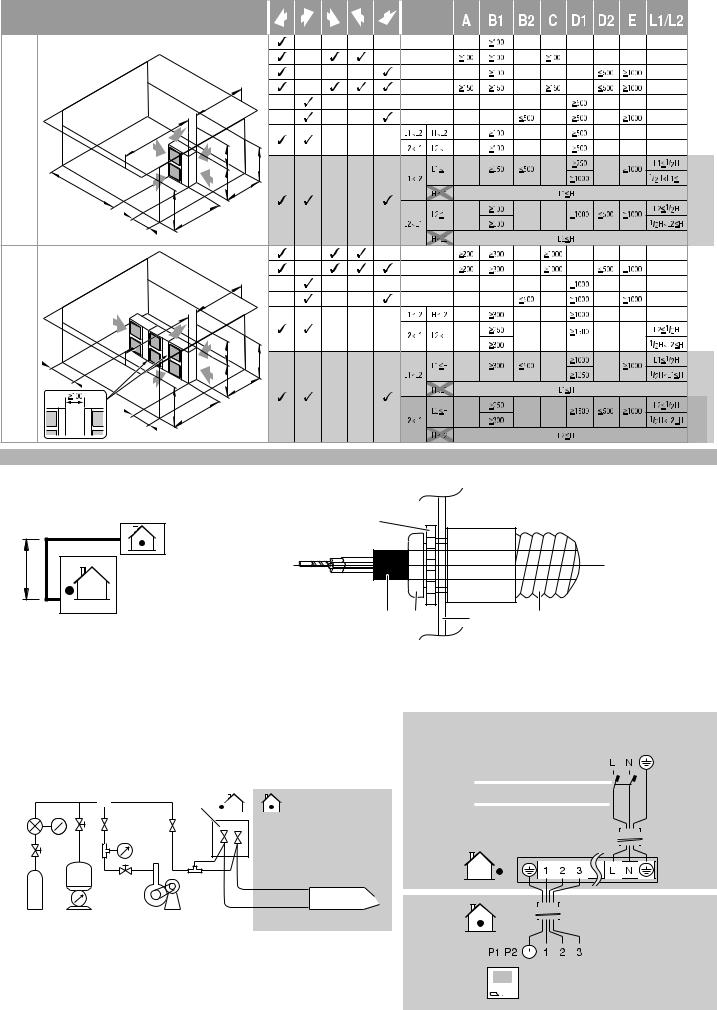
|
|
|
B2 |
|
|
(A-1) |
|
D2 |
|
|
|
|
|
E |
|
|
|
|
|
|
L1 |
|
|
|
|
|
|
|
|
C |
|
|
H |
B1 |
1 |
|
|
|
|
||
|
A |
L2 |
D1 |
|
|
|
|
|
|||
|
|
|
|
||
|
|
|
|
|
|
|
|
|
B2 |
|
|
(A-2) |
|
D2 |
|
|
|
|
|
E |
L1 |
|
|
C |
|
|
|
||
|
|
|
1 |
||
|
|
H |
B1 |
||
|
|
|
|||
|
|
|
|
||
|
A |
L2 |
D1 |
|
2 |
|
|
|
|||
|
|
|
|
||
|
|
|
|
|
|
1 |
|
|
|
|
|
|
|
|
|
A |
B |
L1 |
|
|
|
3 |
|
|
|
|
|
|
|
| <![if ! IE]> <![endif]>H1 |
|
|
|
|
|
1 |
2 |
4 |
5 |
2 |
|
3 |
V1-type
~220-240 V
50 Hz
|
|
|
|
|
|
|
|
|
|
|
|
|
|
1 |
|
|
|
|
|
|
|
||
|
|
|
|
|
|
|
|
|
|
|
|
|
|
|
|
|
|
|
|
|
|||
1 |
|
|
|
|
|
|
6 |
|
|
|
2 |
|
|
|
|
|
|
|
|||||
|
|
|
|
|
|
|
|
|
|
|
|
|
|
|
|
|
|
|
|
|
|
|
|
|
|
|
|
|
|
|
|
|
|
|
|
|
|
|
|
|
|
|
|
|
|
|
|
3
R410A
2 |
4 |
5 |
|
|
|
|
|
|
|
|
|
|
|
|
|
|
|
|
|
|
|
|
|
|
|
|
|
|
|
|
|
|
|
|
|
|
|
|
|
|
|
|
|||
|
|
|
|
|
|
|
|
|
|
|
|
|
|
|
|
|
|
|
|
|||
|
|
|
|
|
|
|
|
|
|
|
|
|
|
|
|
|
|
|
|
|
|
|
|
|
|
|
|
|
|
|
|
|
|
|
|
|
|
|
|
|
|
|
|
|
|
|
|
|
|
|
|
|
|
|
|
|
|
|
|
|
|
|
|
|
|
|
|
|
|
|
|
|
|
|
|
|
|
|
|
|
|
|
|
|
|
|
|
|
|
|
|
|
|
|
|
|
|
|
|
|
|
|
|
|
|
|
|
|
|
|
|
|
|
|
|
|
|
|
|
|
|
|
|
|
|
|
|
|
|
|
|
|
|
|
|
|
|
|
|
|
|
|
|
|
|
|
|
|
|
|
|
|
|
|
|
|
|
|
|
|
3 



4 |
|
5 |
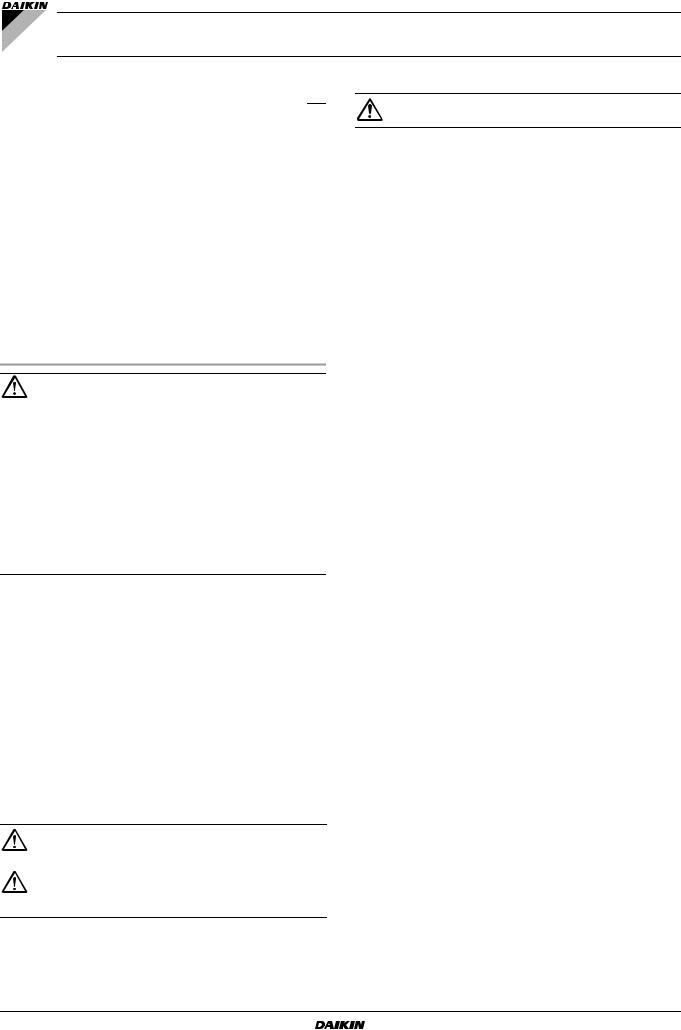
RZQG71LV1B
RZQG100LV1B
RZQG125LV1B Split System air conditioners Installation manual
RZQG140LV1B
CONTENTS |
Page |
Safety precautions............................................................................. |
1 |
Before installation.............................................................................. |
2 |
Selecting installation site................................................................... |
3 |
Precautions on installation ................................................................ |
4 |
Installation servicing space ............................................................... |
4 |
Refrigerant pipe size and allowable pipe length................................ |
5 |
Precautions on refrigerant piping ...................................................... |
6 |
Refrigerant piping.............................................................................. |
7 |
Evacuating ........................................................................................ |
9 |
Charging refrigerant .......................................................................... |
9 |
Electrical wiring work ...................................................................... |
10 |
Test operation.................................................................................. |
12 |
Disposal requirements .................................................................... |
13 |
Wiring diagram ................................................................................ |
14 |
Warning
■For year round cooling applications with low indoor humidity conditions, such as Electronic Data Processing rooms, contact your dealer or see the engineering databook or the service manual.
■For use of air-conditioning units in applications with temperature alarm settings it is advised to foresee a delay of 10 minutes for signalling the alarm in case the alarm temperature is exceeded. The air-conditioning unit may stop for several minutes during normal operation for “defrosting of the indoor unit” or when in “thermostat-stop” operation.
■Ask your dealer or qualified personnel to carry out installation work.
Do not attempt to install the air conditioner yourself. Improper installation may result in water leakage, electric shocks or fire.
■Install the air conditioner in accordance with the instructions in this installation manual.
Improper installation may result in water leakage, electric shocks or fire.
READ THESE INSTRUCTIONS CAREFULLY BEFORE INSTALLATION. KEEP THIS MANUAL IN A HANDY PLACE FOR FUTURE REFERENCE.
IMPROPER INSTALLATION OR ATTACHMENT OF EQUIPMENT OR ACCESSORIES COULD RESULT IN ELECTRIC SHOCK, SHORT-CIRCUIT, LEAKS, FIRE OR OTHER DAMAGE TO THE EQUIPMENT. BE SURE ONLY TO USE ACCESSORIES MADE BY DAIKIN WHICH ARE SPECIFICALLY DESIGNED FOR USE WITH THE EQUIPMENT AND HAVE THEM INSTALLED BY A PROFESSIONAL.
IF UNSURE OF INSTALLATION PROCEDURES OR USE, ALWAYS CONTACT YOUR DAIKIN DEALER FOR ADVICE AND INFORMATION.
The English text is the original instruction. Other languages are translations of the original instructions.
■Consult your local dealer regarding what to do in case of refrigerant leakage. When the air conditioner is to be installed in a small room, it is necessary to take proper measures so that the amount of any leaked refrigerant does not exceed the concentration limit in the event of a leakage. Otherwise, this may lead to an accident due to oxygen depletion.
■Be sure to use only the specified accessories and parts for installation work.
Failure to use the specified parts may result in the unit falling, water leakage, electric shocks or fire.
■Install the air conditioner on a foundation strong enough to withstand the weight of the unit.
A foundation of insufficient strength may result in the equipment falling and causing injury.
■Carry out the specified installation work after taking into account strong winds, typhoons or earthquakes.
Failure to do so during installation work may result in the unit falling and causing accidents.
SAFETY PRECAUTIONS
Please read these “SAFETY PRECAUTIONS” carefully before installing air conditioning equipment and be sure to install it correctly. After completing installation, conduct a trial operation to check for faults and explain to the customer how to operate the air conditioner and take care of it with the aid of the operation manual. Ask the customer to store the installation manual along with the operation manual for future reference.
This air conditioner comes under the term “appliances not accessible to the general public”.
Meaning of WARNING and CAUTION notices.
WARNING
Failure to follow these instructions properly may result in personal injury or loss of life.
CAUTION
Failure to observe these instructions properly may result in property damage or personal injury, which may be serious depending on the circumstances.
■Make sure that a separate power supply circuit is provided for this unit and that all electrical work is carried out by qualified personnel according to local laws and regulations and this installation manual.
An insufficient power supply capacity or improper electrical construction may lead to electric shocks or fire.
■Make sure that all wiring is secured, the specified wires are used, and that there is no strain on the terminal connections or wires. Improper connections or securing of wires may result in abnormal heat build-up or fire.
■When wiring the power supply and connecting the wiring between the indoor and outdoor units, position the wires so that the control box cover can be securely fastened.
Improper positioning of the control box cover may result in electric shocks, fire or overheating terminals.
■If refrigerant gas leaks during installation, ventilate the area immediately.
Toxic gas may be produced if the refrigerant comes into contact with fire.
■After completing installation, check for refrigerant gas leakage. Toxic gas may be produced if the refrigerant gas leaks into the room and comes into contact with a source of fire, such as a fan heater, stove or cooker.
Installation manual |
RZQG71, 100, 125, 140LV1B |
1 |
Split System air conditioners |
3P274408-1 |
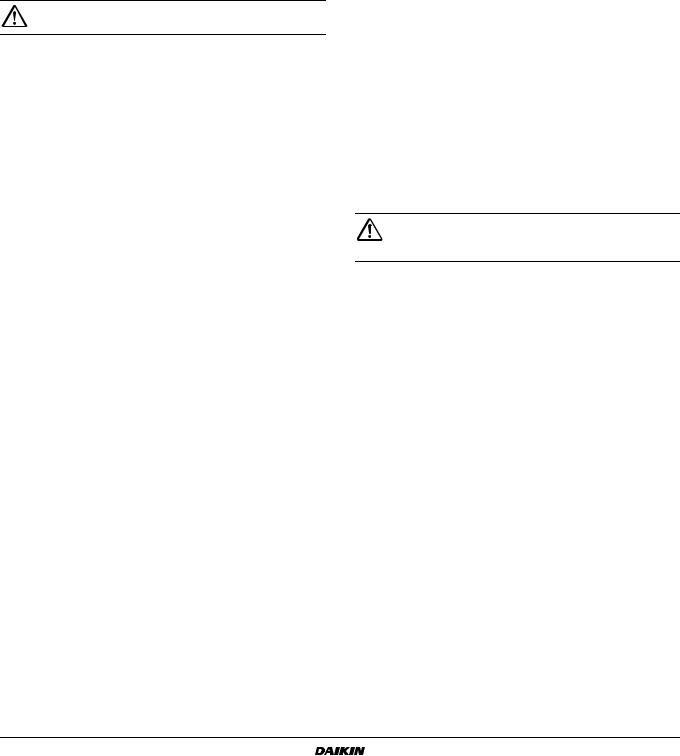
■Never directly touch any accidental leaking refrigerant. This could result in severe wounds caused by frostbite.
■Be sure to switch off the unit before touching any electrical parts.
■Be sure to earth the air conditioner.
Do not earth the unit to a utility pipe, lightning conductor or telephone earth lead.
Imperfect earthing may result in electric shocks or fire.
A high surge current from lightning or other sources may cause damage to the air conditioner.
■Be sure to install an earth leakage breaker.
Failure to install an earth leakage breaker may result in electric shocks or fire.
■Live parts can be easily touched by accident.
Never leave the unit unattended during installation or servicing when the service panel is removed.
■When planning to relocate former installed units, you must first recover the refrigerant after the pumping-down operation. Refer to chapter “Precaution for pumping-down operation” on page 10.
Caution
■While following the instructions in this installation manual, install drain piping to ensure proper drainage and insulate piping to prevent condensation.
Improper drain piping may result in indoor water leakage and property damage.
■Install the indoor and outdoor units, power cord and connecting wires at least 1 m away from televisions or radios to prevent picture interference and noise.
(Depending on the incoming signal strength, a distance of 1 m may not be sufficient to eliminate noise.)
■Remote controller (wireless kit) transmitting distance can be shorter than expected in rooms with electronic fluorescent lamps (inverter or rapid start types). Install the indoor unit as far away from fluorescent lamps as possible.
■Make sure to provide for adequate measures in order to prevent that the outdoor unit be used as a shelter by small animals. Small animals making contact with electrical parts can cause malfunctions, smoke or fire. Please instruct the customer to keep the area around the unit clean.
■Do not rinse the outdoor unit. This may cause electric shocks or fire.
■Do not install the air conditioner in the following locations:
■Where there is a high concentration of mineral oil spray or vapour (e.g. a kitchen).
Plastic parts will deteriorate, parts may fall off and water leakage could result.
■Where corrosive gas, such as sulphurous acid gas, is produced.
Corroding of copper pipes or soldered parts may result in refrigerant leakage.
■Near machinery emitting electromagnetic radiation. Electromagnetic radiation may disturb the operation of the control system and result in a malfunction of the unit.
■Where flammable gas may leak, where there is carbon fibre or ignitable dust suspensions in the air, or where volatile flammables such as paint thinner or gasoline are handled.
Operating the unit in such conditions may result in fire.
■Where the air contains high levels of salt such as that near the ocean.
■Where voltage fluctuates a lot, such as that in factories.
■In vehicles or vessels.
■Where acidic or alkaline vapour is present.
■The air conditioner is not intended for use in a potentially explosive atmosphere.
Provide a logbook
In accordance with the relevant national and international codes, it may be necessary to provide a logbook with the equipment containing at least
-info on maintenance,
-repair work,
-results of tests,
-stand-by periodes,
-etc...
In Europe, EN378 provides the necessary guidance for this logbook.
BEFORE INSTALLATION
■Important PR: Insulation resistance of the compressor.
If, after installation, refrigerant accumulates in the compressor, the insulation resistance can drop, but if it is at least 1 MΩ, then the machine will not break down.
■Turn on the power and leave it on for six hours. Then, check to see if the insulation resistance of the compressor has risen or not.
The compressor will heat up and evaporate any refrigerant in the compressor.
Check the following items if the ground-fault circuit interrupter is triggered.
■Make sure that the interrupter is compatible with high frequencies.
This unit has an inverter, so an interrupter capable of handling high frequencies is needed to prevent malfunction of the interrupter itself.
Precautions for R410A
Since maximum working pressure is 4.0 MPa or 40 bar, pipes of larger wall thickness may be required. Refer to paragraph “Selection of piping material” on page 5.
■The refrigerant requires strict cautions for keeping the system clean, dry and tight.
-Clean and dry
Foreign materials (including mineral oils or moisture) should be prevented from getting mixed into the system.
-Tight
Read “Precautions on refrigerant piping” on page 6 carefully and follow these procedures correctly.
■Since R410A is a mixed refrigerant, the required additional refrigerant must be charged in its liquid state. (If the refrigerant is in state of gas, its composition changes and the system will not work properly).
■The connected indoor units must be indoor units designed exclusively for R410A.
■Refer to catalogue for connected indoor unit model name.
If connecting indoor unit to other than specified, normal operation cannot be performed.
Installation
■For installation of the indoor unit(s), refer to the indoor unit installation manual.
■Illustrations show class 125 outdoor unit type. Other types also follow this installation manual.
■Never operate the unit with a damaged or disconnected discharge thermistor and suction thermistor, burning of the compressor may result.
■Be sure to confirm the model name and the serial no. of the outer (front) plates when attaching/detaching the plates to avoid mistakes.
■When closing the service panels, take care that the tightening torque does not exceed 4.1 N•m.
RZQG71, 100, 125, 140LV1B |
Installation manual |
Split System air conditioners |
2 |
3P274408-1 |
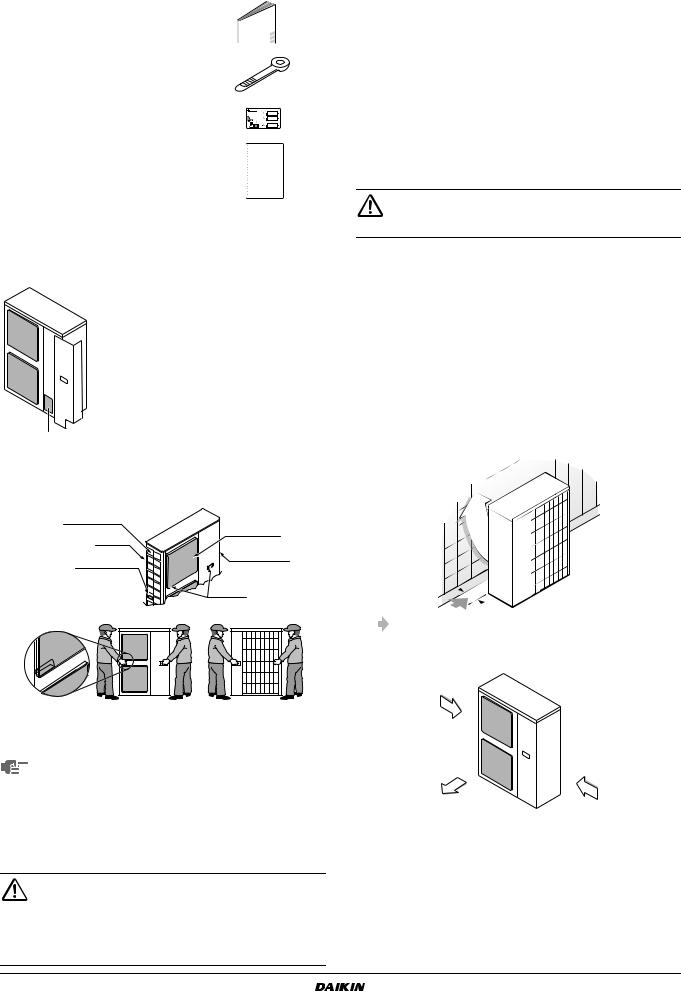
Accessories
Check if the following accessories are included with the unit
Installation manual |
1 |
|
|
|
|
|
|
|
|
|
|
|
|
|
|
|
|
|
|
|
|||
|
|
|
|
|
|
|
|
|
|
|
|
|
|
|
|
|
|
|
|
|
|
|
|
Clamp |
2 |
|
|
|
|
|
|
|
|
|
|
|
|
|
|
|
|
|
|
|
|
|
|
Fluorinated greenhouse gases |
1 |
|
|
|
|
|
|
|
|
|
|
|
|
|
|
|
|
|
|
|
|
||
label |
|
|
|
|
|
|
|
|
|
|
|
|
|
|
|
|
|
|
|
|
|
|
|
Multilingual fluorinated |
1 |
|
|
|
|
|
|
|
|
|
|
|
|
|
|
|
|
|
|
|
|
||
|
|
|
|
|
|
|
|
|
|
||
|
|
|
|
|
|
|
|
|
|
||
|
|
|
|
|
|
|
|
|
|
||
|
|
|
|
|
|
|
|
|
|
||
|
|
|
|
|
|
|
|
|
|
||
|
|
|
|
|
|
|
|
|
|
||
|
|
|
|
|
|
|
|
|
|
||
greenhouse gases label |
|
|
|
|
|
|
|
|
|
|
|
|
|
|
|
|
|
|
|
|
|||
|
|
|
|
|
|
|
|
|
|
|
|
|
|
|
|
|
|
|
|
|
|
|
|
|
|
|
|
|
|
|
|
|
|
|
|
|
|
|
|
|
|
|
|
|
|
|
|
|
|
|
|
|
|
|
|
|
|
|
|
|
|
|
|
|
|
|
|
|
|
|
|
|
|
|
|
|
|
|
|
|
|
|
|
|
|
|
|
|
|
|
|
|
|
|
|
|
|
|
|
|
|
|
|
|
|
|
|
|
|
|
|
|
|
|
|
|
|
|
|
CE-Declaration of conformity |
1 |
|
|
|
|
|
|
|
|
|
|
|
|
|
|
|
|
|
|
|
|
||
|
|
|
|
|
|
|
|
|
|
|
|
|
|
|
|
|
|
|
|
|
|
|
|
See the figure below for the location of the accessories.
1 Accessories
1
Handling
As shown in the figure, bring the unit slowly by grabbing the left and right grips.
Suction inlet
Outlet grille
Corner |
|
Handle |
Outdoor unit |
|
|
100~140 |
|
class models |
Handle |
|
Do not holding the suction inlet in the side of the casing, otherwise the casing could be deformed.
(Place your hands on the corner in the case of 71 class model.)
■ Take care not to let hands or objects come in contact with rear fins.
■Work in a team of at least two people when carrying the unit.
Only hold the unit at the specified positions when carrying it using PP bands or other items.
SELECTING INSTALLATION SITE
■Make sure to provide for adequate measures in order
to prevent that the outdoor unit be used as a shelter by small animals.
■Small animals making contact with electrical parts can cause malfunctions, smoke or fire. Please instruct the customer to keep the area around the unit clean.
1Select an installation site where the following conditions are satisfied and that meets with your customer’s approval.
-Places which are well-ventilated.
-Places where the unit does not bother next-door neighbours.
-Safe places which can withstand the unit’s weight and vibration and where the unit can be installed level.
-Places where there is no possibility of flammable gas or product leak.
-The appliance shall not be placed nor used in a potentially explosive atmosphere.
-Places where servicing space can be well ensured.
-Places where the indoor and outdoor units’ piping and wiring lengths come within the allowable ranges.
-Places where water leaking from the unit cannot cause damage to the location (e.g. in case of a blocked drain pipe).
-Places where the rain can be avoided as much as possible.
This is a class A product. In a domestic environment this product may cause radio interference in which case the user may be required to take adequate measures.
2When installing the unit in a place exposed to strong wind, pay special attention to the following.
Strong winds of 5 m/sec or more blowing against the outdoor unit's air outlet causes short circuit (suction of discharge air), and this may have the following consequences:
-Deterioration of the operational capacity.
-Frequent frost acceleration in heating operation.
-Disruption of operation due to rise of high pressure.
-When a strong wind blows continuously on the face of the
unit, the fan can start rotating very fast until it breaks.
Refer to the figures for installation of this unit in a place where the wind direction can be foreseen.
■Turn the air outlet side toward the building's wall, fence or screen.
Make sure there is enough room to do the installation
■ Set the outlet side at a right angle to the direction of the wind.
Strong wind
Blown air |
Strong wind |
3Prepare a water drainage channel around the foundation, to drain waste water from around the unit.
4If the water drainage of the unit is not easy, please build up the unit on a foundation of concrete blocks, etc. (the height of the foundation should be maximum 150 mm).
5If you install the unit on a frame, please install a waterproof plate within 150 mm of the underside of the unit in order to prevent the invasion of water from the lower direction.
Installation manual |
RZQG71, 100, 125, 140LV1B |
3 |
Split System air conditioners |
3P274408-1 |
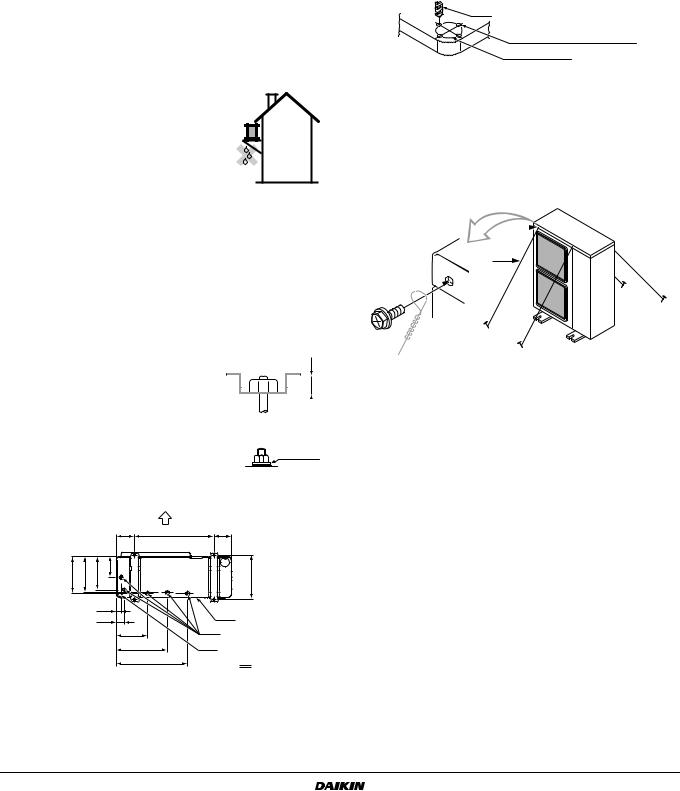
6When installing the unit in a place frequently exposed to snow, pay special attention to the following:
-Place the outdoor unit on a stand (field supply) so that it is not covered by snow falls, snow buildups, or snow drifts. Ensure the bottom plate is at least 500 mm higher than expected snow levels.
-Install a roof cover for a snow fence or other enclosure (field supply).
-Remove the rear suction grille to prevent snow from accumulating on the rear fins.
-Avoid installing the unit in a location where blown snow will build up.
Also take the following measures, as there is a danger the drainage discharged during defrosting operation may freeze.
-Install the outdoor unit at a sufficient height so that its bottom plate is above expected snow levels. This is to prevent the buildup of ice on the underside of the bottom plate. (A space of at least 500 mm is recommended.)
-Do not use a centralized drain plug (option). (There is a danger of freezing when a drain plug or drain pipe is used.)
-If there is a problem with dripping of drainage, take a measure such as positioning a roof cover (field supply) under the outdoor unit.
7If you install the unit on a building frame, please install a waterproof plate (within 150 mm of the underside of the unit) or
use a drain plug kit (option) in order to avoid the drainwater dripping. (See figure.)
PRECAUTIONS ON INSTALLATION
Installation method on the foundation
■Check the strength and level of the installation ground so that the unit will not cause any operating vibration or noise after installation.
■In accordance with the foundation drawing in the figure, fix the unit securely by means of the foundation bolts. (Prepare four sets of M12 foundation bolts, nuts and washers each which are available on the market.)
■It is best to screw in the foundation
bolts until their length are 20 mm from |
|
|
|
|
|
|
|
|
|
|
|
the foundation surface. |
|
|
|
|
|
|
|
<![if ! IE]> <![endif]>20 |
|
||
|
|
|
|
|
|
|
|
|
|
|
|
|
|
|
|
|
|
|
|
|
|
|
|
|
|
|
|
|
|
|
|
|
|
|
|
|
|
|
|
|
|
|
|
|
|
|
|
|
|
|
|
|
|
|
|
|
|
|
|
■Fix the outdoor unit to the foundation
bolts using nuts with resin washers. (Refer |
Resin |
to the right-hand drawing.) |
washers |
If the coating on the fastening area is |
|
stripped off, the nuts rust easily. |
|
A
160 620
B
| <![if ! IE]> <![endif]>285 |
<![if ! IE]> <![endif]>279 |
<![if ! IE]> <![endif]>260 |
<![if ! IE]> <![endif]>161 |
|
|
|
36 |
|
|
|
61 |
262
416
595
AFront (Air outlet side)
BLeg pitch
CBottom frame
160
| <![if ! IE]> <![endif]>B |
<![if ! IE]> <![endif]>(345~355) |
C
D
E
F
DDrain hole
EKnockout hole
FBottom view (mm)
Drain pipe disposal
■Potentially problematic locations for outdoor unit drainage
In locations where, for example, drainage may fall on passersby or frozen drainage may cause passersby to slip over, install an enclosure (field supply) to prevent people approaching the outdoor unit.
■In regions where buildups of snow can be expected, the accumulation and freezing of snow in the space between the heat exchanger and external plate may lower operating efficiency. In this case, drill a knockout hole in the lower part of the bottom frame so the snow can escape. When creating a knockout hole, use a Ø6 mm drill bit to open round holes connected to the circumference of the knockout hole (4 places).
■After punching the knockout hole, the application of repair-type paint on the surface around the edge sections is recommended to prevent rust.
Drill
Area around knockout hole
Knockout hole
Installation method for prevention of falling over
If it is necessary to prevent the unit from falling over, install as shown in the figure.
■prepare all 4 wires as indicated in the drawing
■unscrew the top plate at the 4 locations indicated A and B
■put the screws through the nooses and screw them back tight
A
 B
B
C
Alocation of the 2 fixation holes on the front side of the unit
Blocation of the 2 fixation holes on the rear side of the unit
Cwires: field supply
INSTALLATION SERVICING SPACE
■The installation service spaces shown in these drawings are based on an outdoor unit intake area temperature of 35°C (DB) for COOL operation. If the planned intake area temperature exceeds 35°C (DB), or if the heat load of all outdoor units is increased significantly and exceeds the maximum operating capacity, secure a larger space than that indicated by the intake dimensions in these drawings.
■For installation, consider both pedestrian and airflow paths and choose a suitable pattern from these drawings to match the space available onsite. (If the number of units to be installed exceeds the patterns in these drawings, consider using shortcircuits.)
■Regarding the front space, position the units with consideration to the space required for the onsite refrigerant piping work. (Consult your dealer if the work conditions do not match those in the drawings.)
RZQG71, 100, 125, 140LV1B |
Installation manual |
Split System air conditioners |
4 |
3P274408-1 |
